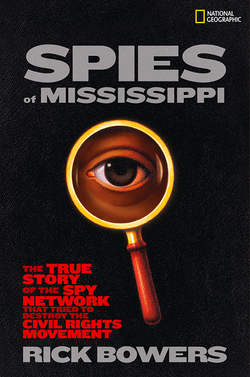Читать книгу Spies of Mississippi: The True Story of the Spy Network that Tried to Destroy the Civil Rights Movement - Rick Bowers - Страница 8
PROLOGUE
ОглавлениеTwelve of the most powerful men in the state controlled a secretive network of spies and informants. A cadre of covert operatives used code names like Agent X, Agent Y, and Agent Zero. Neighbors spied on neighbors. Teachers spied on students. Ministers spied on churchgoers. Spies spied on spies. This is not the description of a Cold War–era secret police force or a futuristic sci-fi dictatorship. This government-run spy network infiltrated the lives of private citizens right here in the United States and not too long ago—in the state of Mississippi during the height of the civil rights movement of the 1950s and 1960s.
The Mississippi State Sovereignty Commission operated as a clandestine investigative arm of the state government for more than a decade. It compiled secret files on more than 87,000 private citizens and organizations. Staffed by a team of professional agents and funded by taxpayers, the commission had a fundamental mission: to save segregation at all costs. In the process, its agents carried out the most extensive state spying program in U.S. history.
How do we know all this is true? The Commission itself tells us. The 134,000 pages and 87,000 names in its once-secret investigative file tell the story of its clandestine programs, its network of neighborhood informants, its brutal behind-the-scenes maneuvering, and its intervention in many of the most significant events of the civil rights era. In their own words, the agents reveal their tactics for infiltrating civil rights groups, forcing liberal college professors out of their jobs, collaborating with white racist organizations, and rewarding black leaders for supporting segregation.
The extensive investigative file does not tell the whole story, however. For this book, I’ve filled out the story with oral histories, personal memoirs, historical studies, academic dissertations, government documents, and newspaper and magazine articles from the era. In addition, I’ve traveled Mississippi—from the cotton fields in the Mississippi River Delta to the beach towns on the Gulf Coast to the capital of Jackson—interviewing people connected to the story. I’ve also uncovered surveillance documents and photographs, including a hand-drawn map showing the burial site of three murdered civil rights workers and photos of student protesters with red numbers scrawled next to their faces. Those numbers targeted the “subversives” for further investigation.
Despite the tracks left behind by the anti–civil rights spies and the excellent research and writing on the subject in Mississippi, the story remains largely unknown to the general public. It is usually relegated to a footnote in the history of the civil rights movement.
No longer.
This is how it happened.
